Assessment of Water Quality Target Attainment and Influencing Factors Using the Multivariate Log-Linear Model in the Nakdong River Basin, Republic of Korea
Abstract
1. Introduction
2. Materials and Methods
2.1. Description of the Study Area
2.2. Approach Methods
2.2.1. Method of Data Collection
2.2.2. Description of Multivariate Log-Linear Model
2.2.3. Evaluation Method for the Multivariate Log-Linear Model
3. Results and Discussions
3.1. Application of Multivariate Log-Linear Model
3.2. Interpreting of Model Parameters
3.3. Evaluation of Bias and Accuracy Estimations
3.4. Assessment of the Attainment of the 2018 Water Quality Target
4. Conclusions
Author Contributions
Funding
Institutional Review Board Statement
Informed Consent Statement
Data Availability Statement
Acknowledgments
Conflicts of Interest
References
- Ministry of Environment (MOE). Republic of Korea, The Evaluation Regulations of Water Quality Target; Ministry of Environment (MOE): Sejong, Korea, 2019; p. 1.
- Johnson, N.M.; Likens, G.E.; Bormann, F.H.; Fisher, D.W.; Pierce, R.S. A working model for the variation in stream water chemistry at the Hubbard Brook Experimental Forest, New Hampshire. Water Resour. Res. 1969, 5, 1353–1363. [Google Scholar] [CrossRef]
- Hirsch, R.M.; Slack, J.R.; Smith, R.A. Techniques of trend analysis for monthly water quality data. Water Resour. Res. 1982, 18, 107–121. [Google Scholar] [CrossRef]
- Smith, R.A.; Hirsch, R.M.; Slack, J.R. A Study of Trends in Total Phosphorous Measurements at Stations in the NASQAN Network; Technical Report Water Supply Paper 2190; U.S. Geological Survey: Reston, VA, USA, 1982; pp. 1–8.
- Cohn, T.A.; Caulder, D.L.; Gilroy, E.J.; Zynjuk, L.D.; Summers, R.M. The validity of a simple log-linear model for estimation fluvial constituent loads—An empirical study involving nutrient loads entering Chesapeake Bay. Water Resour. Res. 1992, 28, 2353–2364. [Google Scholar] [CrossRef]
- Na, E.H.; Park, S.S. Continuity simulation and trend analysis of water qualities in incoming flows to Lake Paldang by log linear models. Korean J. Limnol. 2003, 36, 336–343. [Google Scholar]
- Shin, M.H.; Seo, J.Y.; Choi, Y.H.; Kim, J.; Shin, D.; Lee, Y.J.; Jung, M.S.; Lim, K.J.; Choi, J. Evaluation of LOADEST model applicability for NPS pollutant loads estimation from agricultural watershed. J. Korean Soc. Water Qual. 2009, 25, 212–220. [Google Scholar]
- Park, Y.S.; Lee, J.M.; Shin, Y.; Shin, M.H.; Park, J.H.; Hwang, H.; Ryu, J.; Park, J. Evaluation of regression models in LOADEST to estimate suspended solid load in Hangang Waterbody. J. Korean Soc. Agric. Eng. 2015, 57, 37–45. [Google Scholar]
- Kim, K.; Kang, M.S.; Song, J.H.; Park, J. Estimation of LOADEST coefficients according to watershed characteristics. J. Korean Water Resour. 2018, 51, 151–163. [Google Scholar]
- Lee, J.H.; Lee, S.H.; Lee, S.H.; Lee, J.K. Evaluation of attainment ratio on water quality goal of the mid-watershed representative station. J. Korean Soc. Water Environ. 2017, 33, 525–530. [Google Scholar]
- U.S. Environmental Protection Agency (EPA). An Approach for Using Load Duration Curves in the Development of TMDLs; U.S. Environmental Protection Agency: Washington, DC, USA, 2007.
- Hwang, H.S.; Park, B.K.; Kim, Y.S.; Park, K.J.; Cheon, S.U.; Lee, S.J. Research on the applicability of the load duration curve to evaluate the achievement of target water quality in the unit watershed for a TMDL. J. Korean Soc. Water Environ. 2011, 27, 885–895. [Google Scholar]
- Park, J.H.; Kim, K.S.; Hwang, K.S.; Lee, Y.W.; Lim, B.G. Application of load duration curve and estimation of delivery ratio by flow durations using discharge load rating curve at Jiseok Stream Watershed. J. Korean Soc. Water Environ. 2013, 29, 523–530. [Google Scholar]
- Kim, E.K.; Ryu, J.C.; Kim, H.T.; Kim, Y.S.; Shin, D.S. Application of the load duration curve (LDC) to evaluate the achievement rate of target water quality in the Han-River Watersheds. J. Korean Soc. Water Environ. 2015, 31, 732–738. [Google Scholar] [CrossRef][Green Version]
- Ha, D.W.; Kim, S.G.; Song., C.S.; Ko, G.Y. Effect analysis on target water quality change by measurement data in Yochon a point using load duration curve. J. Korean Soc. Environ. Technol. 2016, 17, 105–113. [Google Scholar]
- Hesel, D.R.; Hirsch, R.M. Statistical Methods in Water Resources: U.S. Geological Survey, Techniques of Water-Resources Investigations, 04-A3; U.S. Geological Survey: Reston, VA, USA, 2002; p. 522.
- Lystrom, D.J.; Rinella, F.A.; Rickert. D., A.; Zimmermann, L. Multiple Regression Modeling Approach for Regional Water Quality Management; Environmental Research Laboratory, EPA-600/778-198; U.S. Environmental Protection Agency, U.S. Department of the Interior: Portland, OR, USA, 1978; p. 60.
- Lizárraga, J.S. Nutrient and Sediment Concentrations, Trends, and Loads from Five Subwatersheds in the Patuxent River Basin, Maryland, 1986–1996; U.S. Geological Survey Water-Resources Investigations Report 98-4221; U.S. Geological Survey: Reston, VA, USA, 1999; p. 31.
- Runkel, R.L.; Crawford, C.G.; Cohn, T.A. Load Estimator (LOADEST)—A Fortran Program for Estimating Constituent Loads in Streams and Rivers; U.S. Geological Survey Techniques and Methods, 4-A5; U.S. Geological Survey: Reston, VA, USA, 2004; p. 69.
- Hirsch, R.M. Large biases in regression-based constituent flux estimates: Causes and diagnostic tools. J. Am. Water Resour. Assoc. 2014, 50, 1401–1424. [Google Scholar] [CrossRef]
- Lathrop, T.R.; Bunch, A.R.; Downhour, M.S. Regression Models for Estimating Sediment and Nutrient Concentrations and Loads at the Kankakee River, Shelby, Indiana, December 2015 through May 2018; U.S. Geological Survey Scientific Investigation Report 2019-5087; U.S. Geological Survey: Reston, VA, USA, 2019; p. 13.
- Choi, J.Y.; Han, D.H. Development of Water Quality Standard for TOC as Organic Matter Index. Seoul Stud. 2001, 12, 173–184. [Google Scholar]
- Nakdong River Environment Research Center (NIER). Changes of Water Environment and Phytoplankton Community Structures in the Nakdong River; 11-1480523-001712-01; National Institute of Environmental Research: Incheon, Korea, 2013; pp. 3–5.
- Park, J.S.; Wang, D.; Lee, W.H. Evaluation of weir construction on water quality related to algal blooms in the Nakdong River. Environ. Earth Sci. 2018, 77, 408. [Google Scholar] [CrossRef]
- Korea Meteorological Administration (KMA). Available online: http://data.kma.go.kr (accessed on 17 December 2019).
- National Institute of Environmental Research (NIER). Report of the National Pollution Source Survey; Based on the 2017, 11-1480523-000429-10; National Institute of Environmental Research: Incheon, Korea, 2019; p. 143.
- Water Environment Information System (WEIS). Available online: http://water.nier.go.kr (accessed on 15 December 2019).
- Water Resources Management Information System (WAMIS). Available online: http://www.wamis.go.kr (accessed on 15 December 2019).
- My Water System (K-Water). Available online: http://www.water.or.kr (accessed on 17 December 2019).
- Rim, C.S. Comparison of incoming solar radiation equations for evaporation estimation. CNU J. Agric. Sci. 2011, 38, 129–143. [Google Scholar]
- Park, H.S.; Park, S.J.; Lim, J.G. Forecasting advertising communication effects using TV advertising exposure data. Broadcast. Commun. 2018, 19, 165–197. [Google Scholar]
- Lewis, C.D. Industrial and Business Forecasting Methods; Butterworth Publishing: London, UK, 1982; p. 40. [Google Scholar]
- Ministry of Environment (MOE). The 2nd Basic Plan for Water Environment Management; 11-1480000-001483-14; Ministry of Environment (MOE): Sejong, Korea, 2018; p. 28.
- Ahn, J.H.; Han, D.H.; Cho, J.H.; Kim, S.B.; Lee, S.M. Assessing the Feasibility of Strengthening Point-Source Nitrogen Management Policy. Korea Environment Institute: Sejong, Korea, 2018; p. 52. [Google Scholar]
- National Institute of Environmental Research (NIER). Report of the National Water Quality Assessment; 11-1480523-002395-10; National Institute of Environmental Research: Incheon, Korea, 2018; p. 29.
- Lee, B.K.; Kim, H.J.; Hyun, Y.J.; Jung, S.H.; Kim, E.Y. A Study for Integrated Management of Water Quantity and Quality to Improve the Water Environment of 4 Rivers Restoration Project; Research Report 2012-04; Korean Environment Institute (KEI): Sejong, Korea, 2012; pp. 525–530. [Google Scholar]
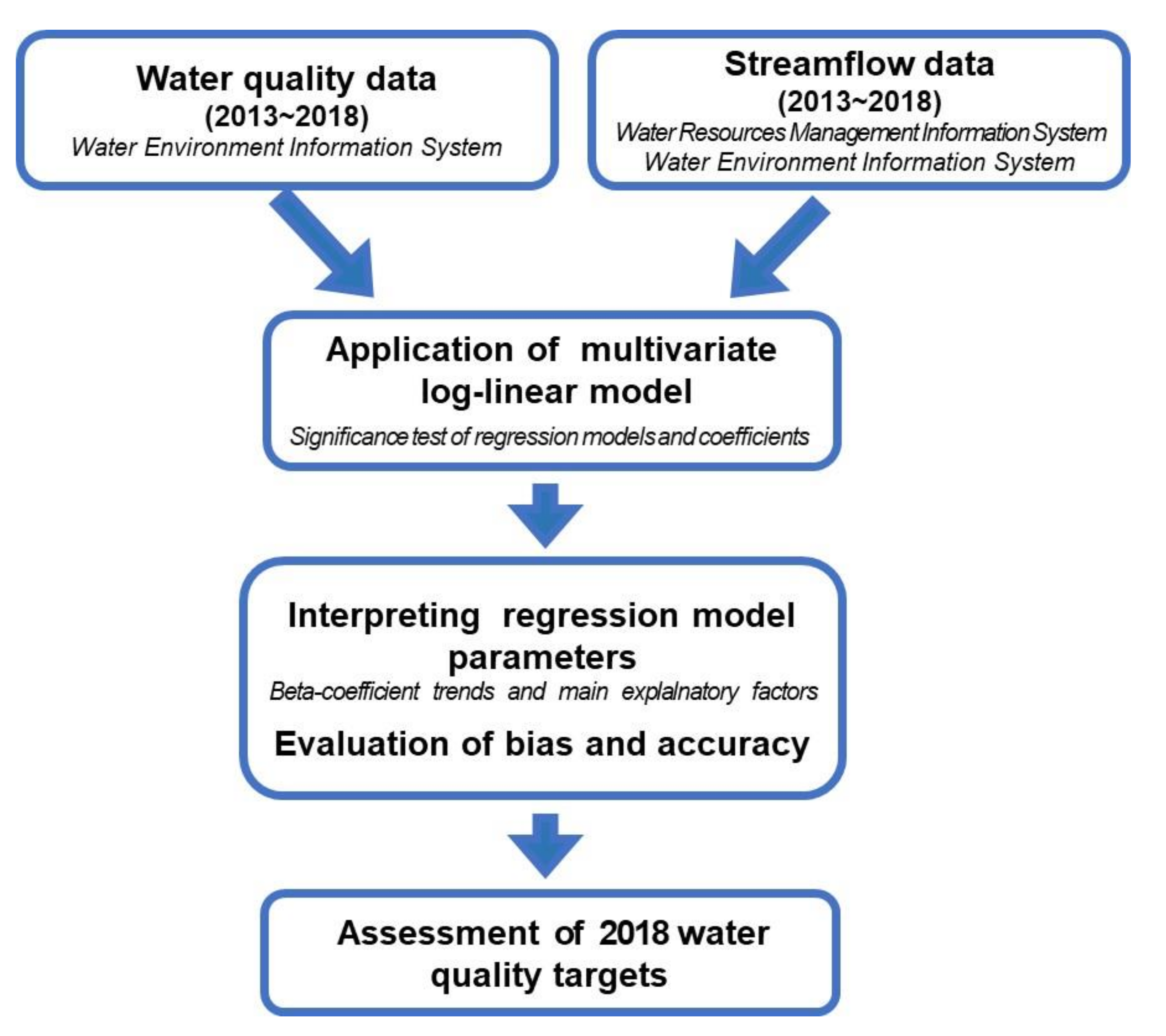
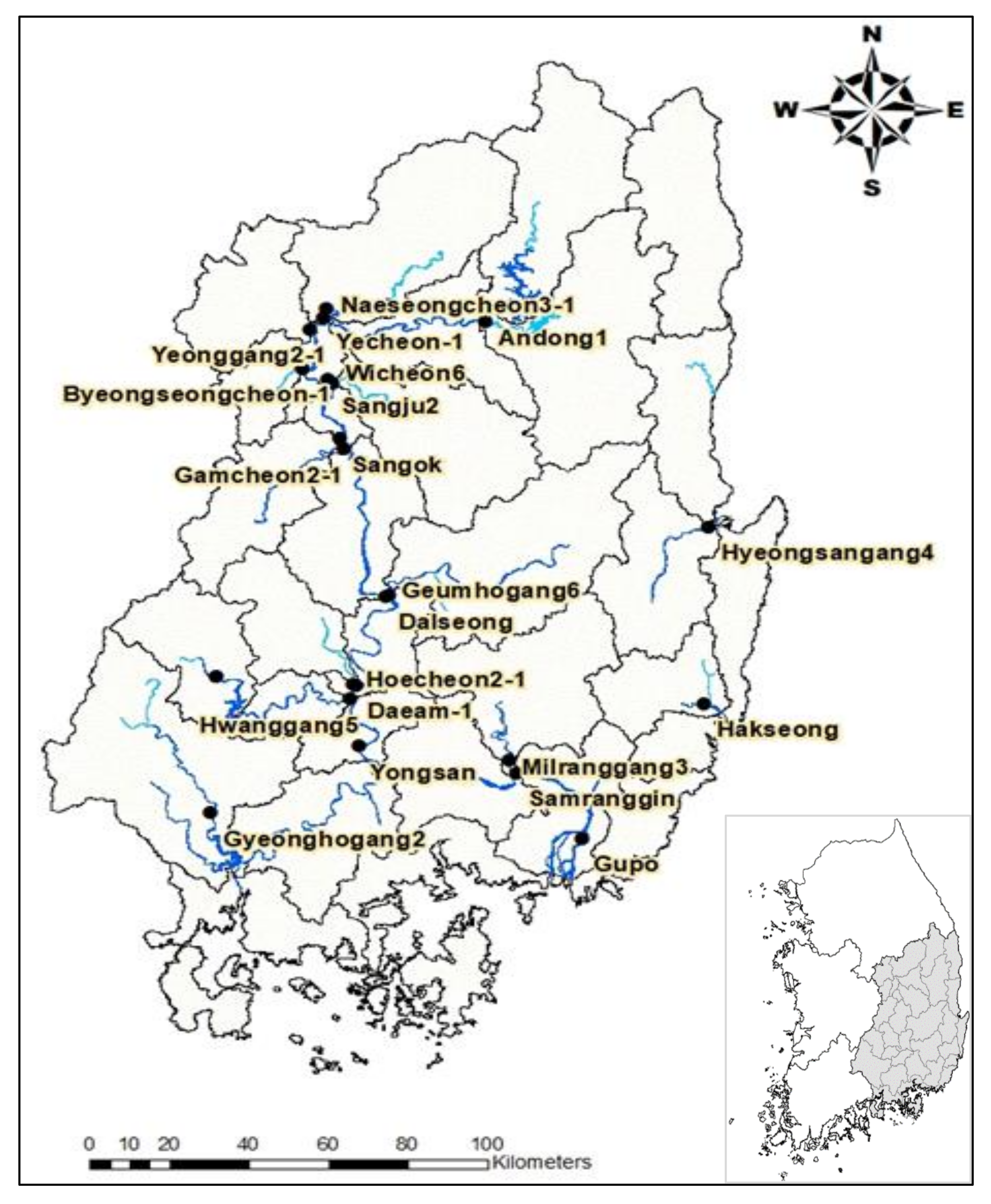
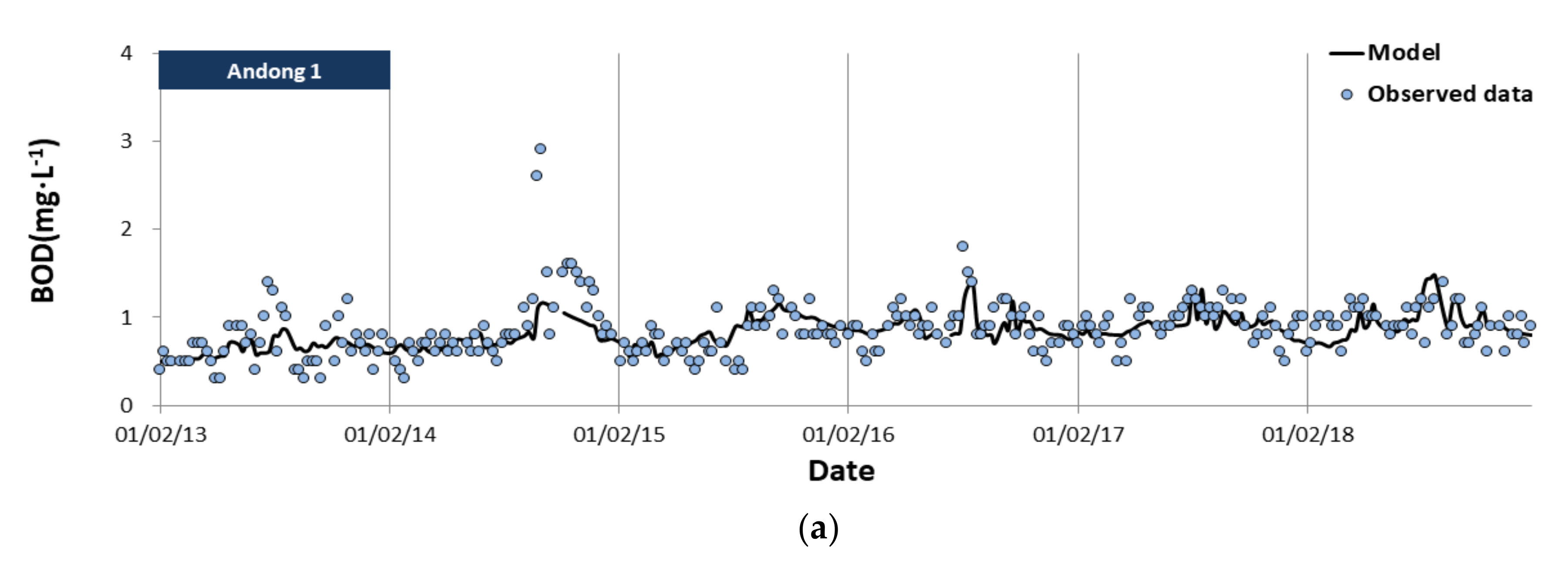
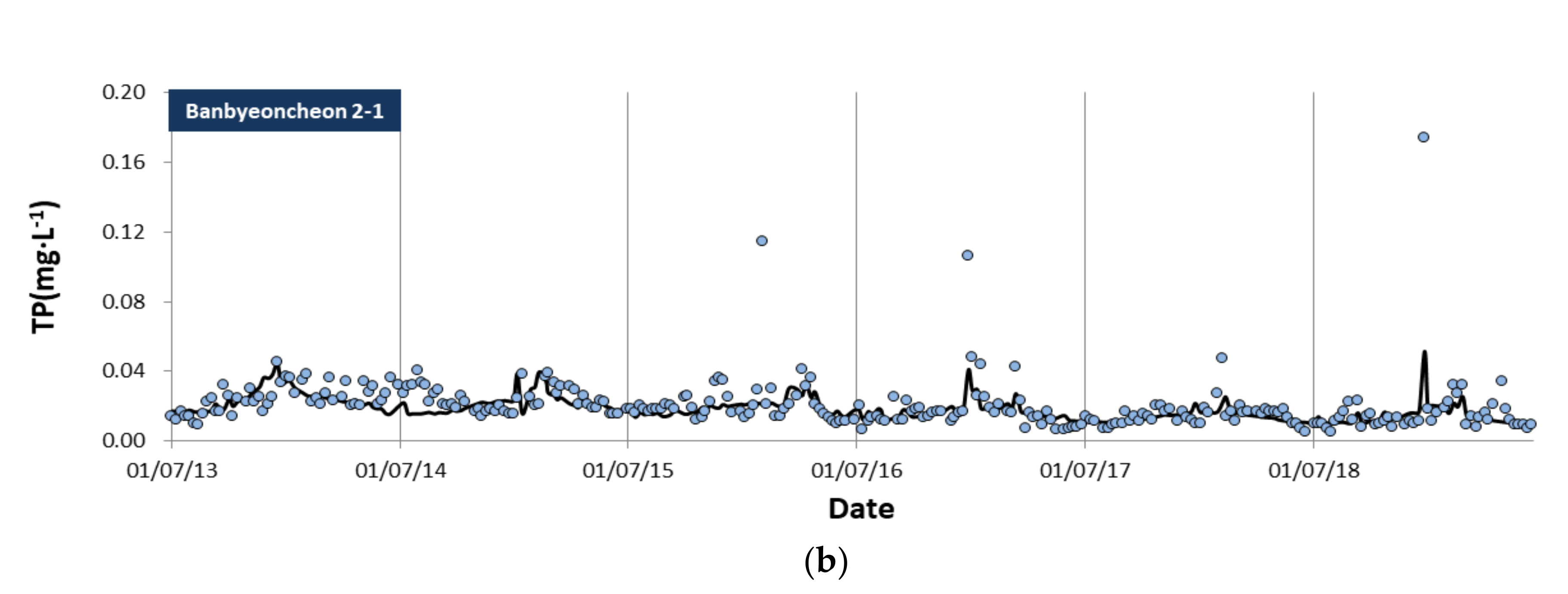
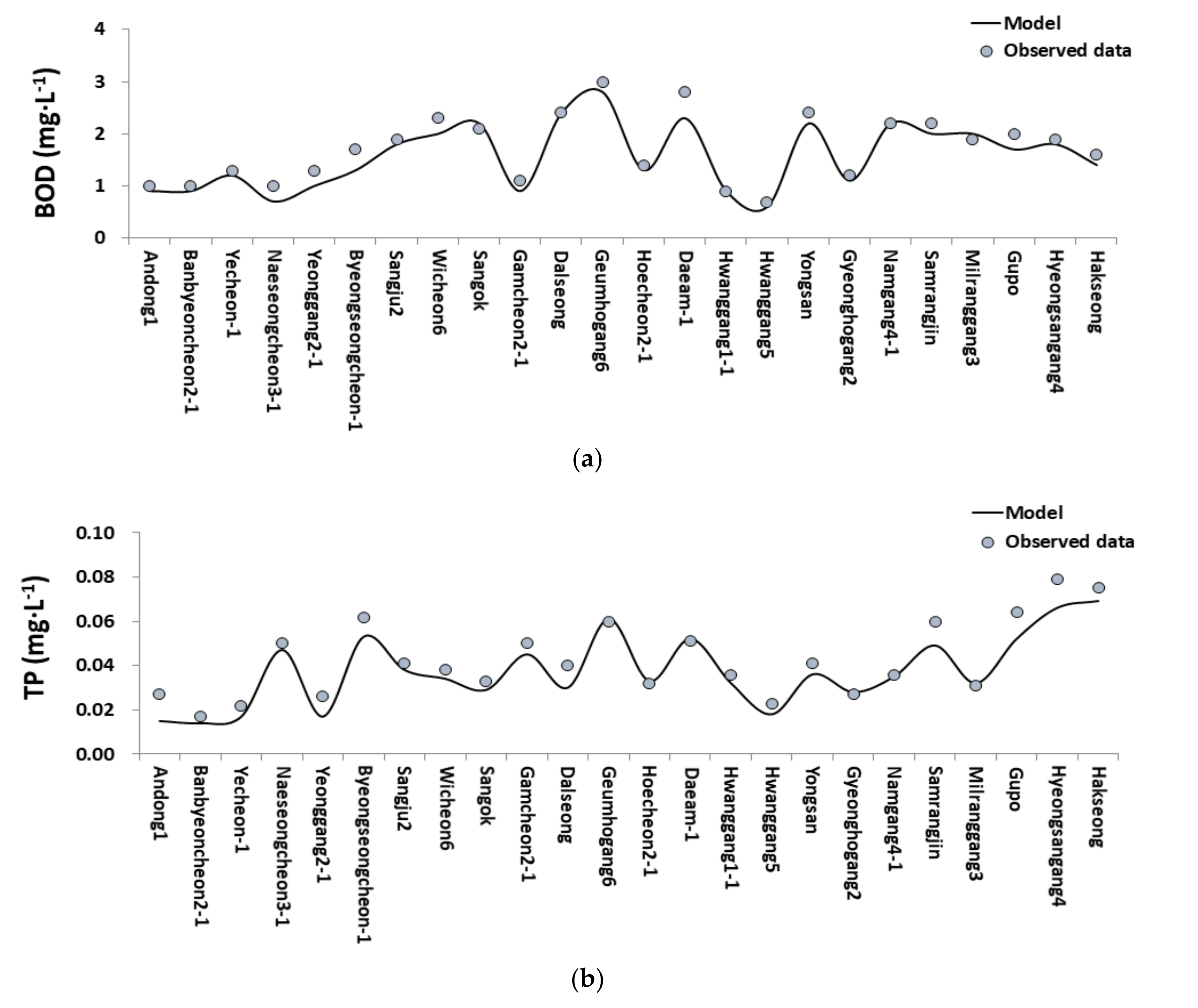
| MAPE | Interpretation |
|---|---|
| <10 | Highly accurate forecasting |
| 10–20 | Good forecasting |
| 20–50 | Reasonable forecasting |
| >50 | Inaccurate forecasting |
| Site | Biological Oxygen Demand (BOD) (mg·L−1) | Total Phosphorous (TP) (mg·L−1) | ||||
|---|---|---|---|---|---|---|
| F | p-Value | Adjusted R2 | F | p-Value | Adjusted R2 | |
| Andong1 | 27.806 | <0.001 | 0.362 | 13.000 | <0.001 | 0.200 |
| Banbyeoncheon2-1 | 13.374 | <0.001 | 0.210 | 38.986 | <0.001 | 0.449 |
| Yecheon-1 | 10.819 | <0.001 | 0.222 | 12.503 | <0.001 | 0.253 |
| Naeseongcheon3-1 | 16.892 | <0.001 | 0.249 | 191.481 | <0.001 | 0.799 |
| Yeonggang2-1 | 21.093 | <0.001 | 0.339 | 26.586 | <0.001 | 0.395 |
| Byeongseongcheon-1 | 18.263 | <0.001 | 0.306 | 61.599 | <0.001 | 0.607 |
| Sangju2 | 9.119 | <0.001 | 0.214 | 27.109 | <0.001 | 0.467 |
| Wicheon6 | 9.394 | <0.001 | 0.176 | 50.522 | <0.001 | 0.558 |
| Sangok | 13.680 | <0.001 | 0.274 | 27.223 | <0.001 | 0.438 |
| Gamcheon2-1 | 13.399 | <0.001 | 0.240 | 134.039 | <0.001 | 0.773 |
| Dalseong | 6.296 | <0.001 | 0.100 | 21.031 | <0.001 | 0.295 |
| Geumhogang6 | 32.781 | <0.001 | 0.399 | 101.119 | <0.001 | 0.677 |
| Hoecheon2-1 | 24.918 | <0.001 | 0.379 | 79.149 | <0.001 | 0.666 |
| Daeam-1 | 8.424 | <0.001 | 0.160 | 38.434 | <0.001 | 0.491 |
| Hwanggang1-1 | 12.837 | <0.001 | 0.504 | 7.893 | <0.001 | 0.375 |
| Hwanggang5 | 6.162 | <0.001 | 0.116 | 40.998 | <0.001 | 0.505 |
| Yongsan | 5.951 | <0.001 | 0.115 | 47.871 | <0.001 | 0.551 |
| Gyeonghogang2 | 27.419 | <0.001 | 0.403 | 96.821 | <0.001 | 0.710 |
| Namgang4-1 | 24.520 | <0.001 | 0.330 | 46.136 | <0.001 | 0.486 |
| Samrangjin | 19.445 | <0.001 | 0.278 | 27.334 | <0.001 | 0.355 |
| Milranggang3 | 29.914 | <0.001 | 0.425 | 18.705 | <0.001 | 0.311 |
| Gupo | 10.883 | <0.001 | 0.171 | 35.621 | <0.001 | 0.420 |
| Hyeongsangang4 | 16.382 | <0.001 | 0.244 | 11.476 | <0.001 | 0.180 |
| Hakseong | 14.588 | <0.001 | 0.573 | 19.902 | <0.001 | 0.285 |
| Site | Variable | β0 | β1 | β2 | β3 | β4 | β5 | β6 |
|---|---|---|---|---|---|---|---|---|
| Andong1 | BOD | −0.016 | −0.148 | −0.063 | 0.054 | −0.005 | −0.079 | −0.205 |
| TP | −3.843 | −0.219 | −0.193 | −0.060 | 0.018 | −0.215 | −0.358 | |
| Banbyeoncheon2-1 | BOD | 0.150 | −0.099 | 0.026 | −0.057 | −0.019 | −0.052 | −0.208 |
| TP | −4.167 | 0.035 | 0.066 | −0.115 | −0.002 | −0.134 | −0.214 | |
| Yecheon-1 | BOD | 0.139 | 0.058 | −0.005 | 0.097 | −0.012 | −0.008 | 0.074 |
| TP | −4.221 | 0.275 | 0.053 | 0.082 | 0.026 | 0.103 | 0.026 | |
| Naeseongcheon3-1 | BOD | −0.148 | 0.256 | 0.049 | −0.028 | −0.048 | 0.208 | −0.203 |
| TP | −3.070 | 0.501 | 0.030 | −0.166 | 0.024 | −0.203 | −0.013 | |
| Yeonggang2-1 | BOD | 0.229 | −0.079 | 0.005 | −0.021 | −0.032 | 0.237 | −0.311 |
| TP | −4.012 | 0.046 | 0.055 | −0.094 | −0.008 | −0.011 | −0.375 | |
| Byeongseongcheon-1 | BOD | 0.344 | 0.102 | 0.064 | −0.043 | −0.017 | 0.257 | −0.312 |
| TP | −2.965 | 0.304 | 0.090 | −0.139 | 0.031 | −0.015 | −0.224 | |
| Sangju2 | BOD | 0.536 | 0.021 | −0.013 | 0.001 | 0.004 | 0.196 | 0.100 |
| TP | −3.707 | 0.297 | 0.101 | 0.020 | 0.035 | 0.253 | −0.064 | |
| Wicheon6 | BOD | 0.730 | −0.017 | −0.019 | −0.012 | 0.006 | −0.046 | −0.304 |
| TP | −3.607 | 0.134 | 0.058 | −0.101 | 0.013 | −0.142 | −0.332 | |
| Sangok | BOD | 0.628 | 0.014 | −0.025 | 0.072 | 0.003 | 0.096 | 0.108 |
| TP | −3.868 | 0.241 | 0.069 | −0.005 | 0.022 | 0.324 | −0.073 | |
| Gamcheon2-1 | BOD | 0.167 | 0.066 | 0.085 | −0.105 | −0.026 | 0.274 | −0.032 |
| TP | −2.945 | 0.351 | 0.061 | −0.266 | 0.039 | −0.117 | −0.113 | |
| Dalseong | BOD | 0.827 | 0.003 | −0.009 | 0.033 | −0.003 | 0.000 | −0.102 |
| TP | −3.601 | 0.144 | 0.039 | −0.063 | 0.016 | −0.329 | −0.129 | |
| Geumhogang6 | BOD | 1.147 | −0.140 | 0.094 | −0.036 | −0.033 | 0.194 | −0.455 |
| TP | −2.478 | 0.178 | 0.084 | −0.151 | −0.005 | −0.097 | −0.337 | |
| Hoecheon2-1 | BOD | 0.131 | −0.038 | 0.060 | −0.039 | −0.003 | 0.168 | −0.314 |
| TP | −3.592 | 0.245 | 0.069 | −0.092 | 0.023 | −0.035 | −0.403 | |
| Daeam-1 | BOD | 0.806 | 0.005 | 0.013 | 0.005 | 0.002 | 0.227 | −0.069 |
| TP | −3.122 | 0.115 | 0.026 | −0.119 | 0.006 | −0.271 | −0.149 | |
| Hwanggang1-1 | BOD | −0.218 | −0.182 | 0.144 | −0.036 | −0.013 | 0.305 | −0.328 |
| TP | −3.363 | 0.042 | 0.089 | −0.126 | 0.012 | −0.087 | −0.382 | |
| Hwanggang5 | BOD | −0.258 | 0.112 | 0.064 | −0.001 | −0.054 | 0.028 | −0.085 |
| TP | −3.766 | 0.350 | 0.026 | −0.086 | 0.001 | −0.191 | −0.142 | |
| Yongsan | BOD | 0.772 | −0.019 | 0.002 | −0.015 | 0.003 | 0.049 | −0.201 |
| TP | −3.212 | 0.183 | 0.062 | −0.142 | 0.015 | −0.369 | −0.198 | |
| Gyeonghogang2 | BOD | 0.063 | −0.012 | 0.100 | −0.082 | −0.013 | 0.185 | −0.234 |
| TP | −3.653 | 0.252 | 0.094 | −0.125 | −0.005 | −0.030 | −0.638 | |
| Namgang4-1 | BOD | 0.789 | −0.167 | −0.017 | −0.003 | 0.008 | 0.015 | −0.338 |
| TP | −3.243 | 0.079 | 0.038 | −0.116 | 0.011 | −0.134 | −0.310 | |
| Samrangjin | BOD | 0.611 | −0.088 | 0.005 | −0.030 | 0.021 | 0.074 | −0.258 |
| TP | −3.165 | 0.246 | 0.071 | −0.039 | 0.025 | −0.204 | −0.093 | |
| Milyanggang3 | BOD | 0.537 | −0.216 | 0.003 | 0.011 | −0.011 | 0.131 | −0.448 |
| TP | −3.343 | 0.002 | 0.070 | −0.087 | −0.010 | 0.018 | −0.181 | |
| Gupo | BOD | 0.589 | −0.041 | 0.011 | −0.040 | 0.003 | 0.127 | −0.188 |
| TP | −3.297 | 0.210 | 0.027 | −0.038 | 0.050 | −0.159 | −0.138 | |
| Hyeongsangang4 | BOD | 0.669 | −0.153 | 0.015 | 0.022 | −0.021 | −0.034 | −0.339 |
| TP | −2.640 | −0.134 | 0.044 | −0.024 | −0.012 | −0.133 | −0.021 | |
| Hakseong | BOD | 0.522 | −0.046 | 0.010 | −0.108 | 0.013 | 0.166 | −0.325 |
| TP | −2.664 | 0.088 | 0.017 | −0.010 | −0.015 | −0.246 | −0.205 |
 Significant (p < 0.05):
Significant (p < 0.05):  .
.| Site | Stream | Variable | Flow (Q) | Time (T) | Seasonality | Main Explanatory Factor |
|---|---|---|---|---|---|---|
| Andong1 | Main | BOD | ↓ | ↑ | O | Q |
| TP | ↓ | ↓ | O | Q | ||
| Banbyeoncheon2-1 | Tributary | BOD | ↓ | ↓ | O | Q |
| TP | ↑ | ↓ | O | T | ||
| Yecheon-1 | Main | BOD | ↑ | ↑ | O | T |
| TP | ↑ | ↑ | - | Q | ||
| Naeseongcheon3-1 | Tributary | BOD | ↑ | - | O | Q |
| TP | ↑ | ↓ | O | Q | ||
| Yeonggang2-1 | Tributary | BOD | ↓ | - | O | Q |
| TP | ↑ | ↓ | O | T | ||
| Byeongseongcheon-1 | Tributary | BOD | ↑ | ↓ | O | Q |
| TP | ↑ | ↓ | O | Q | ||
| Sangju2 | Main | BOD | - | - | O | Q |
| TP | ↑ | - | O | Q | ||
| Wicheon6 | Tributary | BOD | - | - | O | Q |
| TP | ↑ | ↓ | O | Q | ||
| Sangok | Main | BOD | - | ↑ | O | T |
| TP | ↑ | - | O | Q | ||
| Gamcheon2-1 | Tributary | BOD | - | ↓ | O | T |
| TP | ↑ | ↓ | O | T | ||
| Dalseong | Main | BOD | - | ↑ | O | T |
| TP | ↑ | ↓ | O | Q | ||
| Geumhogang6 | Tributary | BOD | ↓ | ↓ | O | Q |
| TP | ↑ | ↓ | O | T | ||
| Hoecheon2-1 | Tributary | BOD | - | ↓ | O | T |
| TP | ↑ | ↓ | O | Q | ||
| Daeam-1 | Main | BOD | - | - | O | T |
| TP | ↑ | ↓ | O | T | ||
| Hwanggang1-1 | Tributary | BOD | ↓ | - | O | Q |
| TP | - | ↓ | O | T | ||
| Hwanggang5 | Tributary | BOD | ↑ | - | O | Q |
| TP | ↑ | ↓ | O | Q | ||
| Yongsan | Main | BOD | - | - | O | T |
| TP | ↑ | ↓ | O | T | ||
| Gyeonghogang2 | Tributary | BOD | - | ↓ | O | T |
| TP | ↑ | ↓ | O | Q | ||
| Namgang4-1 | Tributary | BOD | ↓ | - | O | Q |
| TP | ↑ | ↓ | O | T | ||
| Samrangjin | Main | BOD | ↓ | ↓ | O | Q |
| TP | ↑ | ↓ | O | Q | ||
| Milyanggang3 | Tributary | BOD | ↓ | - | O | Q |
| TP | - | ↓ | O | T | ||
| Gupo | Main | BOD | ↓ | ↓ | O | T |
| TP | ↑ | ↓ | O | Q | ||
| Hyeongsangang4 | Main | BOD | ↓ | - | O | Q |
| TP | ↓ | - | O | Q | ||
| Hakseong | Main | BOD | - | ↓ | O | T |
| TP | ↑ | - | O | Q |
| Site | BOD | TP | ||
|---|---|---|---|---|
| RMSE (mg·L−1) | MAPE (%) | RMSE (mg·L−1) | MAPE (%) | |
| Andong1 | 0.3 | 22.74 | 0.028 | 47.66 |
| Banbyeoncheon2-1 | 0.7 | 34.18 | 0.012 | 29.31 |
| Yecheon-1 | 0.4 | 21.33 | 0.064 | 42.75 |
| Naeseongcheon3-1 | 0.8 | 48.24 | 0.025 | 24.28 |
| Yeonggang2-1 | 0.7 | 35.74 | 0.024 | 33.98 |
| Byeongseongcheon-1 | 1.3 | 40.73 | 0.040 | 26.34 |
| Sangju2 | 0.6 | 25.83 | 0.015 | 38.08 |
| Wicheon6 | 0.9 | 33.56 | 0.016 | 28.73 |
| Sangok | 0.5 | 20.32 | 0.014 | 39.85 |
| Gamcheon2-1 | 0.9 | 45.19 | 0.030 | 23.30 |
| Dalseong | 0.6 | 19.82 | 0.023 | 46.84 |
| Geumhogang6 | 1.5 | 33.31 | 0.030 | 22.51 |
| Hoecheon2-1 | 0.6 | 33.36 | 0.016 | 26.41 |
| Daeam-1 | 0.9 | 29.84 | 0.020 | 28.95 |
| Hwanggang1-1 | 0.5 | 31.98 | 0.023 | 35.47 |
| Hwanggang5 | 0.4 | 41.30 | 0.016 | 29.81 |
| Yongsan | 0.9 | 30.65 | 0.019 | 31.33 |
| Gyeonghogang2 | 0.6 | 29.53 | 0.020 | 30.69 |
| Namgang4-1 | 0.8 | 28.23 | 0.020 | 28.45 |
| Samrangjin | 0.7 | 24.28 | 0.025 | 33.94 |
| Milranggang3 | 0.9 | 36.13 | 0.014 | 26.55 |
| Gupo | 0.8 | 29.68 | 0.023 | 33.65 |
| Hyeongsangang4 | 1.1 | 37.40 | 0.040 | 36.28 |
| Hakseong | 1.5 | 48.95 | 0.048 | 33.79 |
| Site | BOD (mg·L−1) | TP (mg·L−1) | ||||
|---|---|---|---|---|---|---|
| Water Quality Target | Attainment | Water Quality Target | Attainment | |||
| Observed | Estimated | Observed | Estimated | |||
| Andong1 | ≤1 | ○ | ○ | ≤0.02 | Ⅹ | ○ |
| Banbyeoncheon2-1 | ≤2 | ○ | ○ | ≤0.04 | ○ | ○ |
| Yecheon-1 | ≤1 | Ⅹ | Ⅹ | ≤0.02 | Ⅹ | ○ |
| Naeseongcheon3-1 | ≤1 | ○ | ○ | ≤0.02 | Ⅹ | Ⅹ |
| Yeonggang2-1 | ≤1 | Ⅹ | ○ | ≤0.02 | Ⅹ | ○ |
| Byeongseongcheon-1 | ≤2 | ○ | ○ | ≤0.04 | Ⅹ | Ⅹ |
| Sangju2 | ≤1 | Ⅹ | Ⅹ | ≤0.02 | Ⅹ | Ⅹ |
| Wicheon6 | ≤2 | Ⅹ | ○ | ≤0.04 | ○ | ○ |
| Sangok | ≤1 | Ⅹ | Ⅹ | ≤0.02 | Ⅹ | Ⅹ |
| Gamcheon2-1 | ≤1 | Ⅹ | ○ | ≤0.02 | Ⅹ | Ⅹ |
| Dalseong | ≤2 | Ⅹ | Ⅹ | ≤0.04 | ○ | ○ |
| Geumhogang6 | ≤3 | ○ | ○ | ≤0.1 | ○ | ○ |
| Hoecheon2-1 | ≤2 | ○ | ○ | ≤0.04 | ○ | ○ |
| Daeam-1 | ≤3 | ○ | ○ | ≤0.1 | ○ | ○ |
| Hwanggang1-1 | ≤2 | ○ | ○ | ≤0.04 | ○ | ○ |
| Hwanggang5 | ≤1 | ○ | ○ | ≤0.02 | Ⅹ | ○ |
| Yongsan | ≤2 | Ⅹ | Ⅹ | ≤0.04 | Ⅹ | ○ |
| Gyeonghogang2 | ≤2 | ○ | ○ | ≤0.04 | ○ | ○ |
| Namgang4-1 | ≤2 | Ⅹ | Ⅹ | ≤0.04 | ○ | ○ |
| Samrangjin | ≤2 | Ⅹ | ○ | ≤0.04 | Ⅹ | Ⅹ |
| Milranggang3 | ≤2 | ○ | ○ | ≤0.04 | ○ | ○ |
| Gupo | ≤2 | ○ | ○ | ≤0.04 | Ⅹ | Ⅹ |
| Hyeongsangang4 | ≤3 | ○ | ○ | ≤0.1 | ○ | ○ |
| Hakseong | ≤3 | ○ | ○ | ≤0.1 | ○ | ○ |
Publisher’s Note: MDPI stays neutral with regard to jurisdictional claims in published maps and institutional affiliations. |
© 2021 by the authors. Licensee MDPI, Basel, Switzerland. This article is an open access article distributed under the terms and conditions of the Creative Commons Attribution (CC BY) license (https://creativecommons.org/licenses/by/4.0/).
Share and Cite
Kim, M.-A.; Na, E.; Park, S.; Kang, T.; Lee, S. Assessment of Water Quality Target Attainment and Influencing Factors Using the Multivariate Log-Linear Model in the Nakdong River Basin, Republic of Korea. Sustainability 2021, 13, 11094. https://doi.org/10.3390/su131911094
Kim M-A, Na E, Park S, Kang T, Lee S. Assessment of Water Quality Target Attainment and Influencing Factors Using the Multivariate Log-Linear Model in the Nakdong River Basin, Republic of Korea. Sustainability. 2021; 13(19):11094. https://doi.org/10.3390/su131911094
Chicago/Turabian StyleKim, Mi-Ah, Eunhye Na, Suyoung Park, Taegu Kang, and Soyoung Lee. 2021. "Assessment of Water Quality Target Attainment and Influencing Factors Using the Multivariate Log-Linear Model in the Nakdong River Basin, Republic of Korea" Sustainability 13, no. 19: 11094. https://doi.org/10.3390/su131911094
APA StyleKim, M.-A., Na, E., Park, S., Kang, T., & Lee, S. (2021). Assessment of Water Quality Target Attainment and Influencing Factors Using the Multivariate Log-Linear Model in the Nakdong River Basin, Republic of Korea. Sustainability, 13(19), 11094. https://doi.org/10.3390/su131911094







